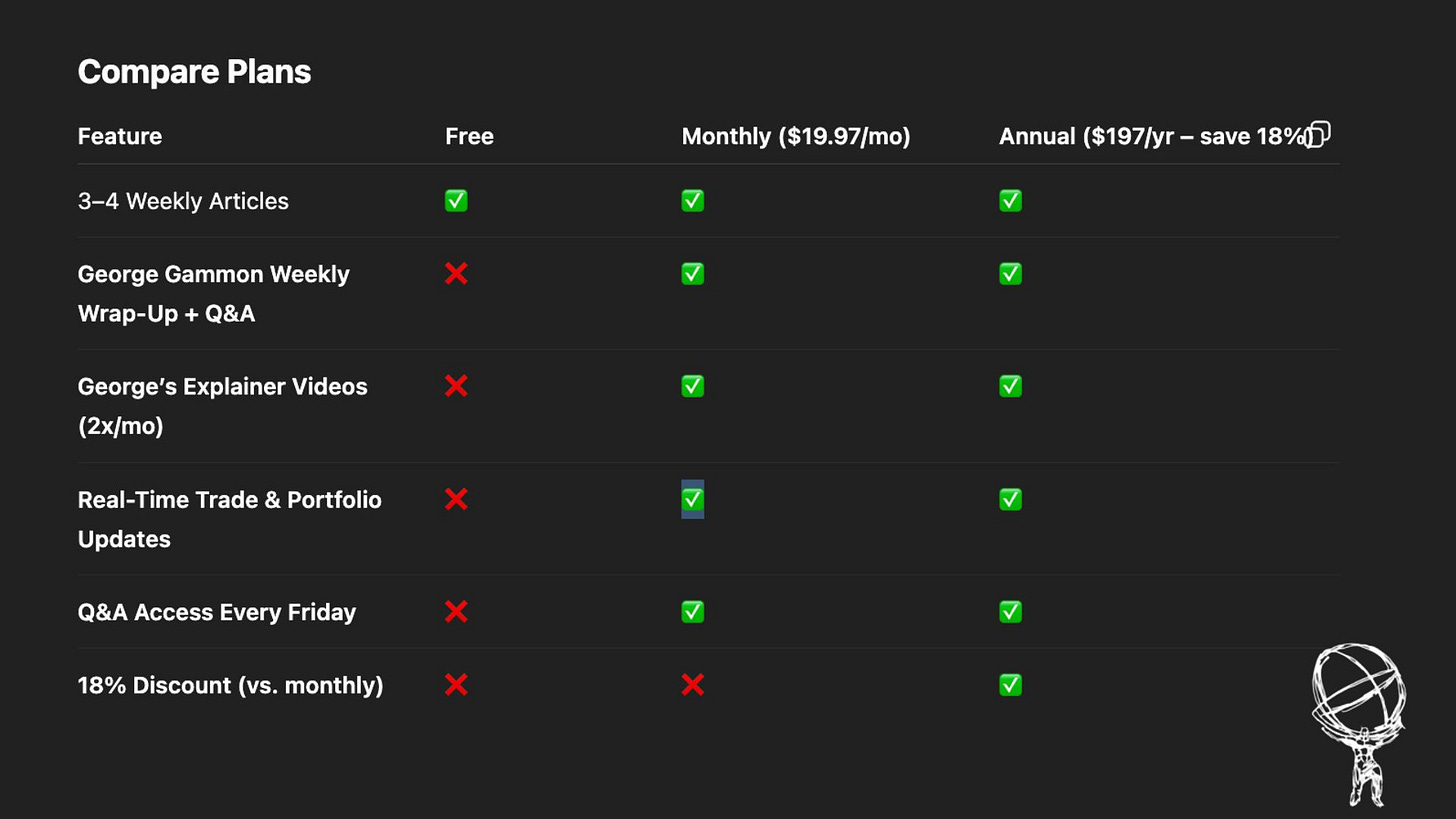Dollar Down, Gold Up
The Real Story Behind the Crashing Greenback
Written by Rebel Capitalist AI | Supervision and Topic Selection by George Gammon | September 17, 2025
The dollar is cratering. That’s not hyperbole. Yesterday, the DXY closed at 96.66…the lowest print year-to-date and a rapid descent from nearly 100 just six weeks ago.
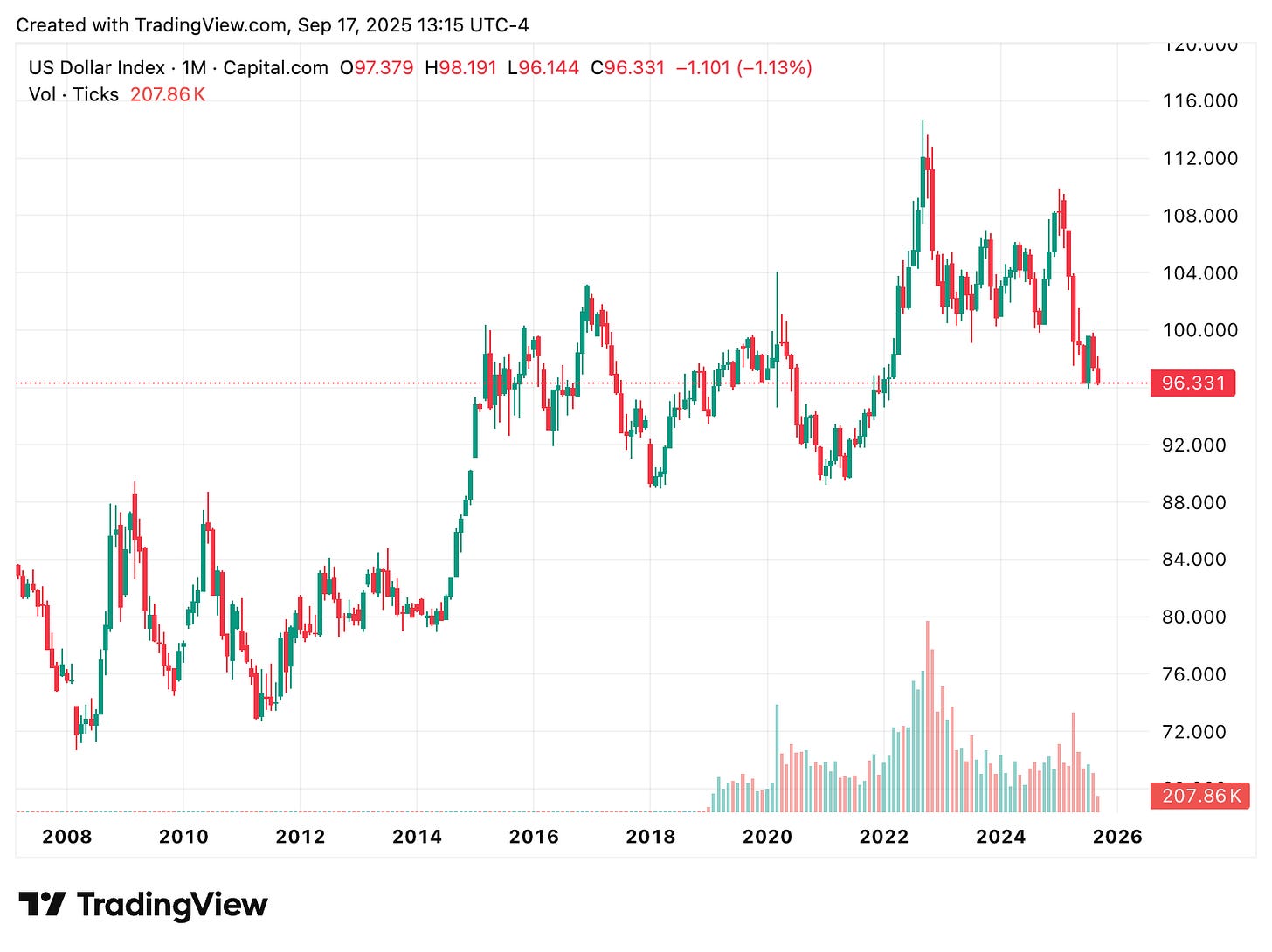
This isn’t just a technical dip. This is a big macro move, and it’s telling us something important about what markets are pricing in. So let’s break it down.
And yes, gold just hit an all-time high above $3,700. More on that later.
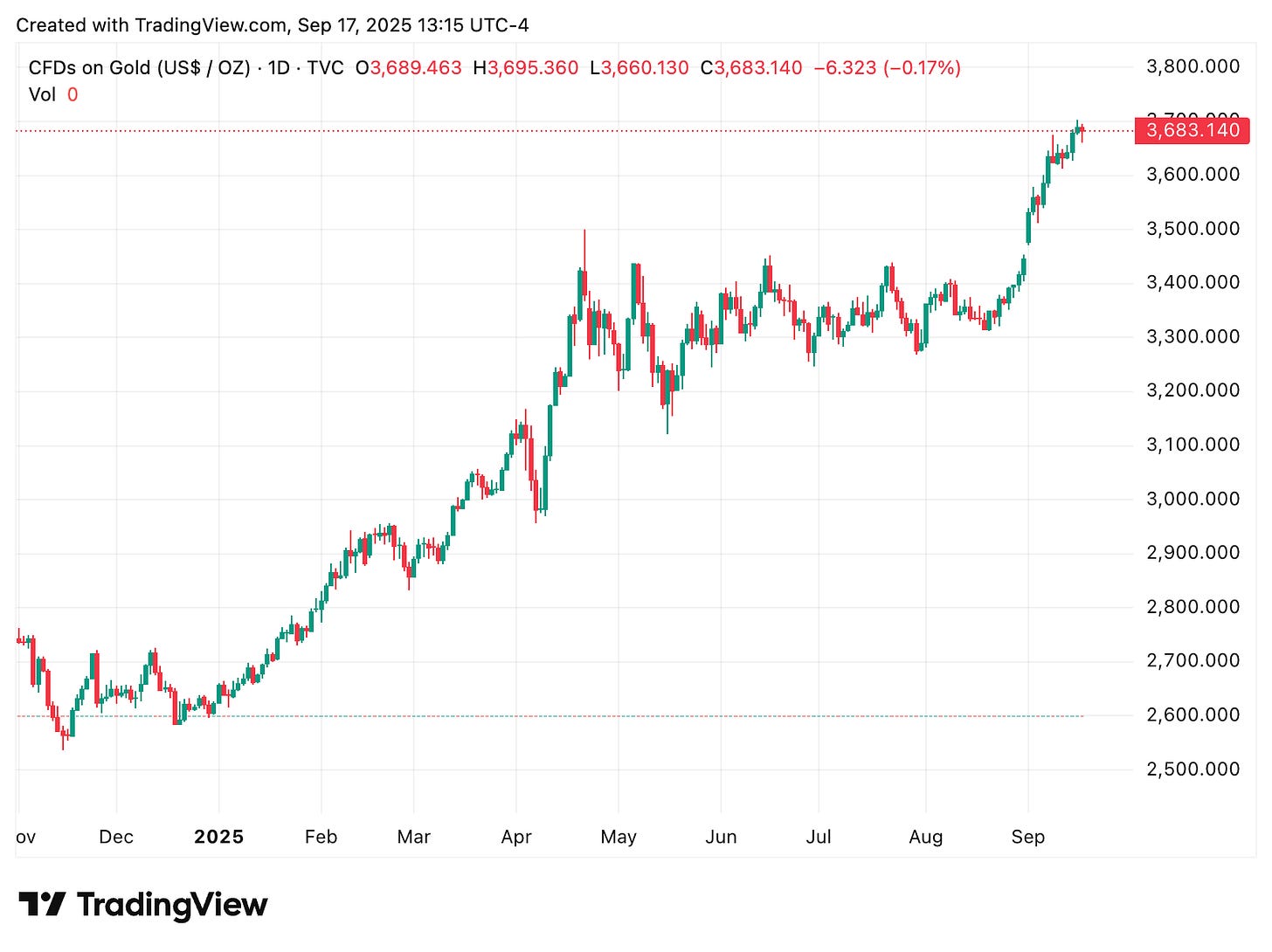
Is the Dollar Losing Reserve Status? Not Even Close
When the dollar drops this fast, the usual suspects start yelling about "de-dollarization" and reserve currency collapse.
Let’s get one thing straight: that’s not what’s happening here.
The dollar is still the plumbing of the global monetary system. The real reason for this drop? Interest rate differentials.
Most investors still can’t grasp this: a falling DXY doesn’t mean the end of the dollar system.
It means the plumbing is working exactly as designed. But if reserve status isn’t at risk, then what is?
The answer lies in the debt that keeps this machine running…and how fragile that system really is.
The Dollar System Is Built on Short-Term Debt
Most people still don’t grasp how dollars are created.
They’re not printed; they’re lent into existence.
Especially outside the U.S., these are short-term dollar loans made by global banks to borrowers who don’t earn dollars. When that debt comes due, those borrowers have to find dollars…fast.
That’s what creates constant demand for dollars, regardless of how people feel about U.S. politics or Trump or anything else.
If you owe dollars, you need dollars. Period.
But what happens when that demand weakens? Or when supply increases faster than demand? That’s when the dollar falls.
Dollar credit doesn’t just appear…it rolls over, again and again, on the shortest maturities possible. That rolling demand has always been the backstop for dollar strength.
But when that rhythm breaks, or when supply swamps demand, you get volatility that feels like freefall.
The key question now: is this just a temporary imbalance, or the start of something bigger?
History has answers.
What History Tells Us About Dollar Weakness
Look at the long-term chart.
In 2001, DXY hit 117.
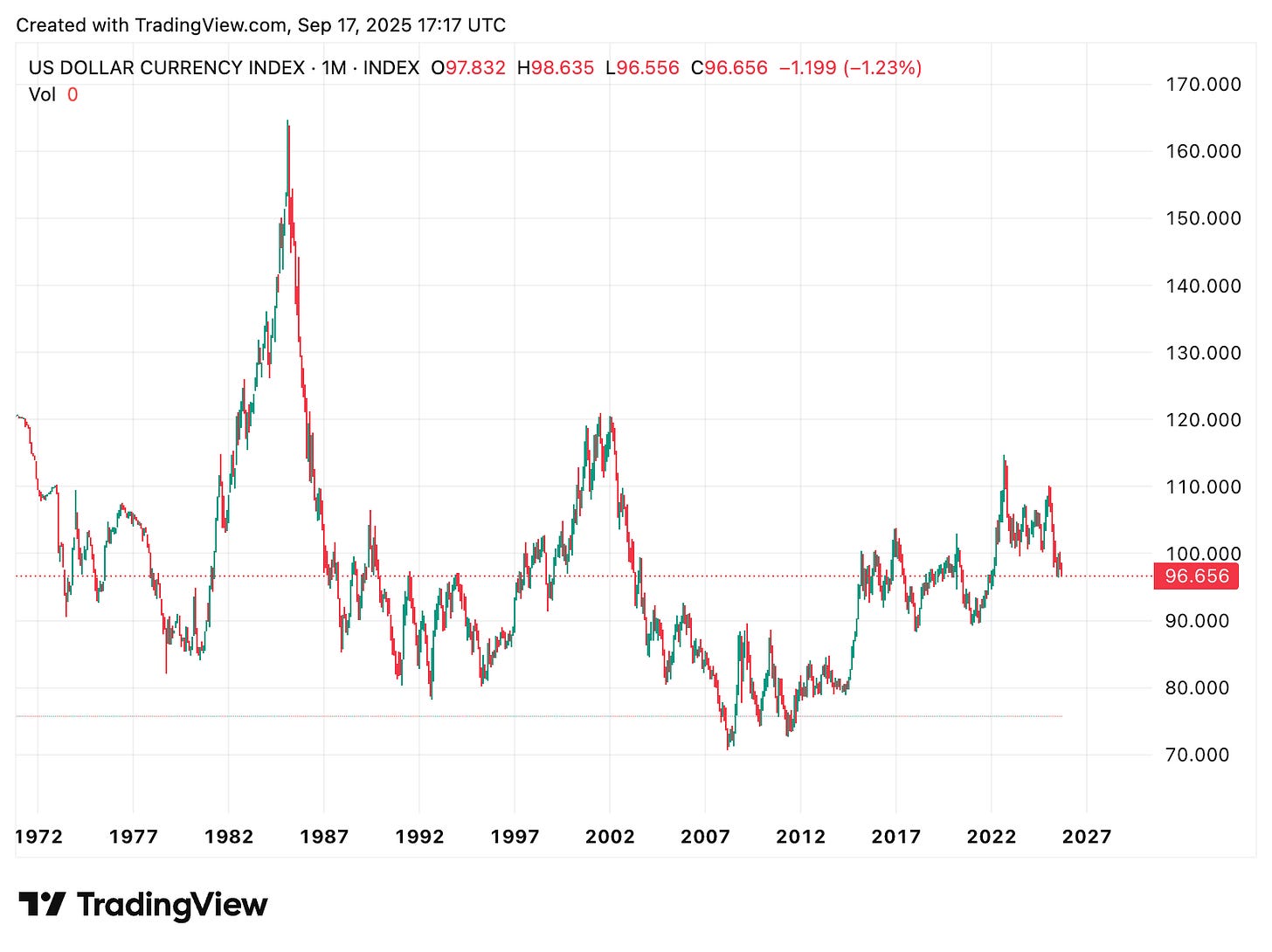
By 2008, it dropped to 72. Was that a sign of de-dollarization? No.
In fact, it was a period of massive global growth, especially in emerging markets.
China was booming. Commodities were on fire. All of that growth needed dollars to function.
The paradox: demand for dollars was rising, but supply was rising even faster.
Global banks were handing out dollar loans like candy, and velocity of money was ramping up.
More loans = more dollars in circulation = dollar down.
So no, dollar weakness isn’t always a bearish signal for the U.S. system. Often, it reflects global growth and excess liquidity.
But that’s not today’s story.
Every major dollar decline in the past four decades has coincided with periods of booming global growth…not collapse.
But today’s setup doesn’t rhyme with those cycles.
This time, it isn’t China’s factories or Brazil’s commodities driving the weakness.
It’s something else entirely: the market’s view on where the Fed is headed.
Today’s Dollar Drop: Rate Differentials Are Driving the Bus
Fast forward to 2025. The dollar has dropped from 100 to 96.66 in about six weeks.
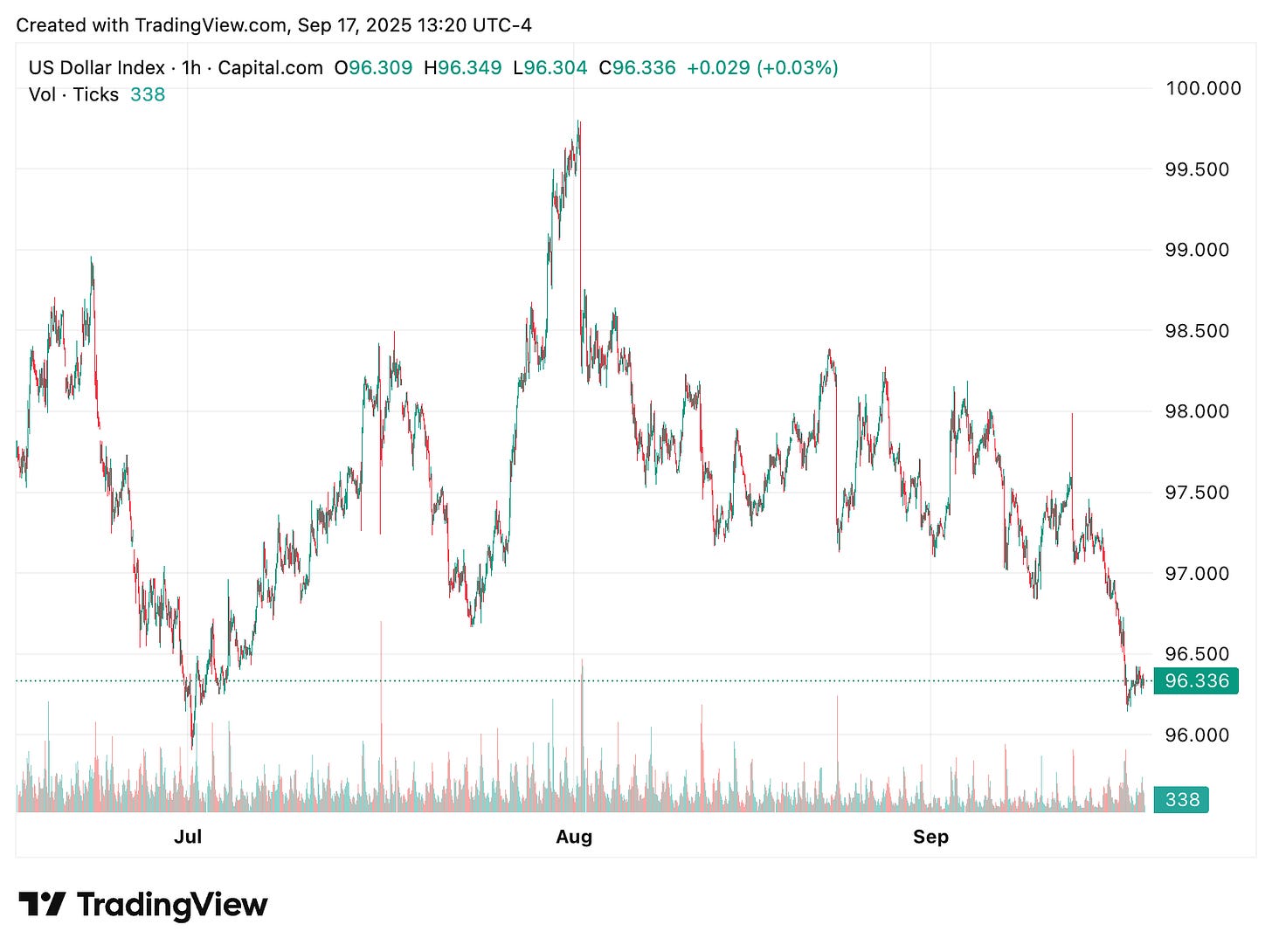
The culprit? Markets are repricing the path of interest rates.
It started with cracks in the labor market:
Negative revisions to non-farm payrolls.
Deteriorating job growth trends.
Softer inflation data.
Suddenly, Wall Street started seeing more than just one or two cuts in 2025.
They began pricing in a dovish pivot. What was a 50bps cut expectation has ballooned to possible 75bps or more.
This shrinks the interest rate differential between the U.S. and the ECB, or the Bank of Japan. And when that differential narrows, the dollar gets sold.
Rate differentials explain the short-term price action, but they don’t explain the bigger puzzle: why the bond market refuses to believe in strong data.
When retail sales can’t stop yields from falling, it tells you something more powerful is in play. And it sets up the next move.
But Wait…Retail Sales Were Strong?
Today, we got hotter-than-expected retail sales. Shouldn’t that push yields up and support the dollar? At first, it did. The two-year spiked.
But then... it reversed. Hard.
Why? Because the bond market called BS. Traders saw through it. They said: “One data point doesn’t change the trend. The labor market is still soft. The Fed is still on a path to cut.”
So we got the classic fade: retail sales pop, then yields fall, dollar drops, gold surges. That’s the real signal.
The “hot” data points that should have strengthened the dollar are being ignored.
Traders are signaling they see through the noise…and they’re betting on cuts, not hikes.
When the market fades good news, it means the narrative is already shifting.
Which begs the question: what invisible mechanics are really steering this ship?
The Mechanics Behind It All
Let’s get nerdy for a minute. The reason dollar moves often don’t make sense to retail investors is because they’re thinking in terms of goods and services, not relative fiat relationships.
The DXY is just a basket of currencies versus the dollar. It says nothing about your grocery bill. It says everything about the capital flows between central banks and institutional allocators.
And in the short run, interest rate differentials dominate those flows.
But in the long run, the mechanics of the eurodollar system take over. If global dollar credit is expanding faster than demand, dollar falls. If liquidity tightens and banks aren’t lending, dollar rises. Simple as that.
Once you see the system as credit creation…not money printing…the moves make sense.
The eurodollar market is the hidden engine, and right now, it’s accelerating supply while demand softens. That combination has a predictable effect. But the bigger story is what happens when the Fed steps in tomorrow.
What Happens Next?
We’ve got a Fed decision today. CME FedWatch is showing a 96% chance of a 25bps cut. That’s aggressive. And remember: the market could be underestimating the dovish tone.
My prediction? We get a dovish 25bps cut with dissent. That is, two or three Fed governors vote against the cut. It’s rare, but not unprecedented. And it would signal internal conflict at the Fed.
Regardless, markets are already pricing in easier policy…and that’s driving the dollar down.
The stage is set for a dovish cut…but the wild card is dissent inside the Fed. If markets smell confusion in the room, volatility will spike. And if that happens, the next asset class in line to respond isn’t currencies at all. It’s gold.
Gold at $3,730: Here Comes the Real Asymmetry
Now let’s talk about the asset that just hit uncharted territory: gold.
Spot price: $3,730.
GDXJ (junior miners): up ~22% in the past month.
GLD (gold ETF): up ~10% over the same period.
I recently rotated some of my gold into GDXJ to play the catch-up trade, and it’s worked beautifully. The miners offer leveraged exposure, and when gold breaks out, they scream.
Today, despite gold pushing higher, GDXJ pulled back ~3%. For me, that’s a gift. Trend is up. Pullback is in. I may be adding to the position.
This is not investment advice. But this is the kind of asymmetrical bet I look for:
Clear macro driver (falling dollar).
Trend breakout.
Volatility giving you a better entry.
Size your risk. Define your max loss. But this setup is hard to ignore.
Gold is screaming higher, miners are following, and pullbacks are being bought. This is where the asymmetry lies: a falling dollar, dovish Fed, and breakout in hard assets.
But the real question is whether the bond market is right…and whether this move is just beginning.
Final Thoughts: Who’s Right?
You’ve got three competing signals:
Retail sales (hawkish).
Treasury curve and DXY (dovish).
My money’s on the bond market and the dollar. They’re calling the bluff. And if they’re right, the path of least resistance is:
Lower yields.
Lower dollar.
Higher gold.
Outperformance in miners.
In that world, the asymmetric trades are already on the move. The question is: are you positioned for it?
As always, play your game. Use stops. Manage risk like a Market Wizard. And remember: the goal isn’t to be right tomorrow. It’s to stack the odds in your favor for the next 3–5 years.
Signals are colliding: strong retail data, weak labor markets, falling yields, and surging gold.
The mainstream will tell you it’s confusing. It isn’t. The bond market and dollar action are pointing in the same direction, and gold is confirming it. The trade is clear…the only question is whether you’ll act before the herd catches on.
When cycles collide, they don’t whisper…they roar. The dollar’s collapse, gold’s breakout, and the Fed’s pivot are flashing signals you can’t ignore. But connecting the dots requires going deeper than the headlines.
That’s what you get at the Rebel Capitalist News Desk…George Gammon’s weekly wrap-up, subscriber-only whiteboard videos, and analysis you won’t find on CNBC or Bloomberg.
The Fed’s decision hits in less than 24 hours. By the time the mainstream spins it, the trades will already be moving. Don’t get left chasing.
👉 Subscribe to Rebel Capitalist News Desk today. Get George’s live wrap-up, whiteboard breakdowns, and stay two steps ahead of Wall Street’s games.




